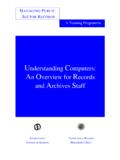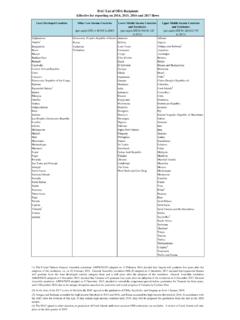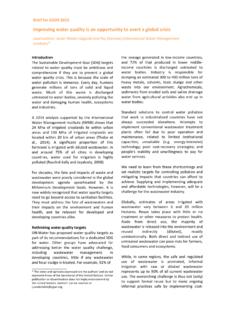Transcription of Development Communication Sourcebook - World …
1 Development . C O M M U N I C AT I O N. Sourcebook . Broadening the Boundaries of Communication Paolo Mefalopulos Development Communication Sourcebook Development Communication Sourcebook Broadening the Boundaries of Communication Paolo Mefalopulos 2008 The International Bank for Reconstruction and Development /The World Bank 1818 H Street NW. Washington DC 20433. Telephone: 202-473-1000. Internet: E-mail: All rights reserved 1 2 3 4 11 10 09 08. This volume is a product of the staff of the International Bank for Reconstruction and Develop- ment / The World Bank. The findings, interpretations, and conclusions expressed in this volume do not necessarily reflect the views of the Executive Directors of The World Bank or the govern- ments they represent.
2 The World Bank does not guarantee the accuracy of the data included in this work. The boundaries, colors, denominations, and other information shown on any map in this work do not imply any judgement on the part of The World Bank concerning the legal status of any ter- ritory or the endorsement or acceptance of such boundaries. Rights and Permissions The material in this publication is copyrighted. Copying and/or transmitting portions or all of this work without permission may be a violation of applicable law. The International Bank for Reconstruction and Development / The World Bank encourages dissemination of its work and will normally grant permission to reproduce portions of the work promptly. For permission to photocopy or reprint any part of this work, please send a request with com- plete information to the Copyright Clearance Center Inc.
3 , 222 Rosewood Drive, Danvers, MA. 01923, USA; telephone: 978-750-8400; fax: 978-750-4470; Internet: All other queries on rights and licenses, including subsidiary rights, should be addressed to the Office of the Publisher, The World Bank, 1818 H Street NW, Washington, DC 20433, USA; fax: 202-522-2422; e-mail: ISBN: 978-0-8213-7522-8. eISBN: 978-0-8213-7523-5. DOI: Library of Congress Cataloging-in-Publication Data Mefalopulos, Paolo. Development Communication Sourcebook : broadening the boundaries of Communication /. Paolo Mefalopulos. p. cm. Includes bibliographical references and index. ISBN 978-0-8213-7522-8 (print) -- ISBN 978-0-8213-7523-5 (electronic). 1. Communication in economic Development . I. World Bank. II. Title.
4 2008. '4--dc22. 2008016703. Cover: Patricia Hord Graphik Design Contents Preface ..xi Abbreviations ..xv Module 1. The Value-Added of Development What Communication ? ..3. The Value-Added of Development Communication in Programs and Ten Key Issues about ( Development ) Communication ..18. Understanding the Scope and Uses of Development Communication ..21. The Operational Framework of the Development Communication Summary of Main Points in Module 1 ..32. Notes ..33. References ..34. Module 2. Reflections on the Theory and Practice of Development Communication ..37. Setting Common Ground on Key Terminology ..39. Development and Communication : An Overview ..43. A Different Take on Development Communication v Contents Combining Theory with Practice: The Multitrack Model.
5 68. Summary of Main Points in Module 2 ..74. Notes ..75. References ..76. Module 3. Development Communication Methodological Framework and Principles and Methodology Fundamentals of the Four-Phase Phase 1 Communication -Based Assessment ..94. Communication -Based Assessment Phase 2 Communication Strategy Design ..111. Communication Strategy Design Toolbox ..126. Phase 3 Implementing the Communication Communication Toolbox for Phase 4 Communication for Monitoring and Communication Toolbox for Monitoring and Evaluation ..147. Summary of Main Points in Module 3 ..149. Notes ..150. References ..151. Module 4. Development Communication Services and Operations at the World Introduction: Development Communication Services and Experiences at the World Part I: DevComm Scope and Service The Development Communication Division Scope and Service Lines.
6 157. vi Contents Notes ..171. Part II: The World of Practice: Some Experiences ..172. Development Communication to Fight Poverty through Poverty Reduction Strategy Notes ..179. Community Radio: Supporting Local Voices through the Airwaves ..180. Notes ..193. Disability and Development : What Role for Communication ? ..195. Notes ..202. How a Multilateral Institution Builds Capacity in Strategic Notes ..213. Assessing the Impact of Development Communication ..214. Notes ..223. Summary of Main Points in Module 4 ..226. Appendix The Rome Boxes Getting Results through Interpersonal Communication Methods ..10. A Typology of Participation in Development Comparing and Contrasting CNA and When a Perfectly Appropriate Technical Solution Does Not Make Much Sense.
7 16. vii Contents The Importance of the First Mile ..62. A Different Use of Communication to Inform and Change The World Congress on Communication for Development (WCCD)..70. The Power of Participatory Communication for Social Change ..96. When Perceptions Diverge ..98. Addressing the Correct Communication Entry Point or A Communication Road Map to Change ..133. Evaluating the Performance of Communication in Public Sector Community Radio in Community-Driven Development Projects: Kenya, Ghana, and Sri Lanka ..188. Community Radio and Women's Participation: Timor-Leste ..190. Community Radio in Disaster Management: Aceh, Figures Windows of Perception in an Agricultural Project ..12. Mice Reconstructing an Image of a Cow.
8 17. DevComm Methodological Framework ..29. The Multitrack Communication Model ..73. The Process DevComm Methodological Framework ..88. Windows of Perceptions in a Software Innovation ..99. Using Communication Materials to Facilitate The Communication Program Design and Implementation Process ..132. viii Contents DevComm Portfolio in FY04 and Basic Phases of a Communication Links between Communication Program and Project Cycle ..170. DevComm Portfolio by Sector in March Tables Common Types of Communication in Development Basic Features of Communication Basic Differences in the Two Communication Modes ..59. Levels of Participation and Communication ..91. The Johari CBA Main Steps ..104. Defining the Objective ..114. Main Steps of Communication Strategy Design.
9 117. The Communication Action Plan ..129. Steps in Developing a Communication Plan for PRSPs ..175. ix Preface The main reason for writing this book was not simply to gather, organize, and dis- seminate knowledge on Development Communication . Rather, it was to make the case for its systematic adoption in Development policies and practices. My long experience in the field made me realize that the media-centric conception of Communication was not making a significant difference in people's lives. Too often the most impor- tant missing element in Development programs was genuine (two-way) communica- tion between the decision makers, the experts, and the so-called beneficiaries. Media, no matter how technologically advanced; messages, no matter how skillful- ly packaged; and information, no matter how relevant, are not enough to bring about meaningful and sustainable results.
10 These results can only be achieved if the people involved (stakeholders) are part of the process leading to change. This realization shift- ed my professional focus from media to people, from the products to the process. My frustration at the frequent misuse of the term Communication for develop- ment has been a major impetus in writing this book. The Sourcebook intends to make clear the seemingly straightforward distinction between Communication about Development operations and results and Communication for Development operations and results. In the first case, Communication is used to inform audi- ences about Development initiatives, activities, and results. It is about transmitting information and messages. In the second case, Communication is applied to engage stakeholders, assess the situation, and devise effective strategies leading to better and more sustainable Development initiatives.
















